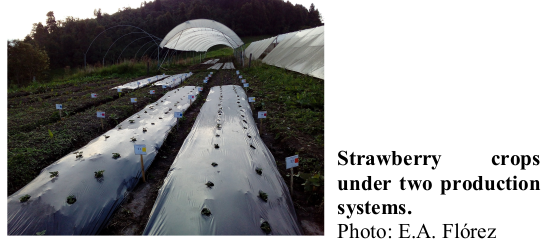Evaluación técnico-económica de consorcios bacterianos en el cultivo de fresa en dos sistemas de producción

Resumen
La producción de fresas se lleva a cabo predominantemente en campos abiertos, lo que la hace vulnerable a los ataques de plagas, lo que puede provocar reducciones en el rendimiento. Esta susceptibilidad se ve exacerbada aún más por las condiciones climáticas adversas. Otro desafío es el alto costo de insumos como los fertilizantes. En consecuencia, el objetivo de este estudio fue evaluar tanto técnica como económicamente el impacto de la aplicación de biofertilizantes bacterianos al cultivo de fresa bajo dos sistemas de producción. El diseño experimental empleado fue un arreglo de parcelas subdivididas en bloques completos al azar, con la parcela principal centrada en el sistema de producción (ya sea campo abierto o macrotúnel), la subparcela sobre acolchado plástico (con o sin) y la subparcela sobre acolchado plástico (ya sea con o sin) sobre tratamientos de consorcios bacterianos comerciales. Estos eran los siguientes: (a) control, que correspondía al manejo convencional de los agricultores; (b) Bacillus subtilis, (c) consorcio 1, que comprendió una mezcla de ácidos húmicos y Rhodopseudomonas palustris, Bacillus subtilis, Bacillus amyloliquefaciens, Bacillus licheniformis; y (d) consorcio 2, compuesto por Azospirillum brasilense, Azotobacter chroococcum, Lactobacillus acidophillus, Saccharomyces cerevisiae. La combinación de producción de macrotúnel y acolchado plástico, junto con la aplicación del consorcio bacteriano 2, arrojaron los mejores resultados en el segundo año, mostrando rendimientos brutos y netos de 25.041 kg ha-1 y 17.330 kg ha-1, respectivamente. Esto se asoció con la relación costo-beneficio más favorable con 1,41 en el segundo año.
Palabras clave
Fragaria spp., Componentes del rendimiento, Plasticultura, Bacterias promotoras de crecimiento, Bio-fertilización
Citas
- Agronet. 2023. Área, producción y rendimiento nacional por cultivo - fresa (database). In: https://www.agronet.gov.co/estadistica/Paginas/home.aspx?cod=1; consulted: February, 2023.
- Álvarez-Medina, A., H.V. Silva-Rojas, S.G. Leyva-Mir, N. Marbán-Mendoza, and A. Rebollar-Alviter. 2017. Resistencia de Botrytis cinerea de fresa (Fragaria x ananassa Duch.) a fungicidas en Michoacan México. Agrociencia 51(7), 783-798.
- Alvarez, M., F. Tucta, E. Quispe, and V. Meza. 2018. Incidencia de la inoculación de microorganismos benéficos en el cultivo de fresa (Fragaria sp.). Sci. Agropec. 9(1), 33-42. Doi: https://doi.org/10.17268/sci.agropecu.2018.01.04
- Axayacatl, O. 2021. Países productores de fresa. In: Blogagricultura, https://blogagricultura.com/paises-productores-fresa/; consulted: February, 2023.
- Botero-Hoyos, A., G. Garzón-Cortés, and N. González-Siabato. 2022. Oportunidades para crear valor y sostenibilidad en la producción de fresa. Rev. EIA 19(38), 1-20. Doi: https://doi.org/10.24050/reia.v19i38.1578
- Calderón, L. D. Angulo, D. Rodríguez, C. Grijalba, and M. Pérez. 2013. Evaluación de materiales para el acolchado de la fresa cultivada bajo invernadero. Rev. Fac. Cienc. Básicas 9(1), 8. Doi: https://doi.org/10.18359/rfcb.352
- Cano, A. 2013. Estrategias biológicas para el manejo de enfermedades en el cultivo de fresa (Fragaria spp). Rev. Colomb. Cienc. Hortic. 7(2), 263-276. Doi: https://doi.org/10.17584/rcch.2013v7i2.2240
- Cenicafe. (2022). Anuario meteorológico cafetero 2021. Centro Nacional de Investigaciones de Café – Cenicafé, Chinchiná, Colombia. Doi: https://doi.org/10.38141/10782/anu2021
- Ceredi, G. C. Antoniacci, E. Montuschi, A. De Paoli, and S. Gengotti. 2009. Ten years of field trial on grey mold control on strawberries. Acta Hort. 842, 327-300. Doi: https://doi.org/10.17660/ActaHortic.2009.842.60
- Encuesta Nacional Agropecuaria. 2023. Departamento Administrativo Nacional de Estadística – DANE. Encuesta Nacional Agropecuaria año 2013, https://www.dane.gov.co/index.php/estadisticas-por-tema/precios-y-costos/sistema-de-informacion-de-precios-sipsa; consulted: February, 2023.
- Flórez, R. and R. Mora. 2010. Fresa (Fragaria x ananassa Duch.) producción y manejo poscosecha. Corredor Tecnológico Agroindustrial; Cámara de Comercio de Bogotá, Bogota.
- Furlani, P. and F. Fernández. 2007. Hidroponía vertical para la producción de fresa. Bull. No. 36. Red Hidroponía. Lima. pp. 8-14.
- Herrera, H., A. Hurtado-Salazar, and N. Ceballos-Aguirre. 2015. Estudio técnico y económico del tomate tipo cereza élite (Solanumlycopersicum L. var. cerasiforme) bajo condiciones semicontroladas. Rev. Colomb. Cienc. Hortic. 9(2), 290-300. Doi: https://doi.org/10.17584/rcch.2015v9i2.4185
- Mendoza-Léon, D., J. Dobronski-Arcos, C. Vásquez-Freytez, V. Frutos-Pinto, and S. Paredes-Carreño. 2019. Control de Tetranychusurticae Koch (Acari: Tetranychidae) con Bacillus subtilis en hojas de fresa (Fragaria vesca). Agron. Costar. 43(1), 125-133. Doi: https://doi.org/10.15517/rac.v43i1.35676
- Minagricultura. 2021. Cadena de la fresa. In: Dirección de Cadenas Agrícolas y Forestales, https://sioc.minagricultura.gov.co/Fresa/Documentos/2021-03-31%20Cifras%20Sectoriales.pdf; consulted: February, 2023.
- Mixquititla-Casbis, G., O. Villegas-Torres, M. Andrade-Rodríguez, H. Sotelo-Nava, and A. Cardoso-Taketa. 2020. Crecimiento, rendimiento y calidad de fresa por efecto del régimen nutrimental. Rev. Mex. Cienc. Agric. 11(6), 1337-1348. Doi: https://doi.org/10.29312/remexca.v11i6.2329
- Moor, U. K. Karp, and P. Poldma. 2004. Effect of mulching and fertilization on the quality of strawberries. Agric. Food Sci. 13(3), 256-267. Doi: https://doi.org/10.2137/1239099042643062
- Mossler, M. 2012. Florida crop/pest management profiles: strawberry. In: https://www.growables.org/information/TropicalFruit/documents/StrawberryCropPestManagementEDIS.pdf; consulted: February, 2023.
- Romero-Romano, C., J. Ocampo-Mendoza, E. Sandoval-Castro, and J. Tobar-Reyes. 2012. Fertilización orgánica-mineral y orgánica en el cultivo de fresa (Fragaria x ananassaDuch.) bajo condiciones de invernadero. Ra Ximhai 8(3), 41-49. Doi: https://doi.org/10.35197/rx.08.03.e1.2012.04.cr
- Rubio, S., A. Alfonso, C. Grijalba, and M. Pérez. 2014. Determinación de los costos de producción de la fresa cultivada a campo abierto y bajo macrotúnel. Rev. Colomb. Cienc. Hortic. 8(1), 67-69. Doi: https://doi.org/10.17584/rcch.2014v8i1.2801
- Salamé-Donoso, T.P., B.M. Santos, C.K. Chandler, and S.A. Sargent. 2010. Effect of high tunnels on the growth, yields, and soluble solids of strawberry cultivars in Florida. Intl. J. Fruit Sci. 10(3), 249-263. Doi: https://doi.org/10.1080/15538362.2010.510420
- SAS. 2013. Statistical Analysis System. SAS User’s guide v 9.4 (CD-ROM). SAS Institute, Cary, NC.
- SIPSA. 2023. Sistema de Información de Precios del Sector Agropecuarios. In: Departamento Administrativo Nacional de Estadística - DANE. https://www.dane.gov.co/index.php/estadisticas-por-tema/agropecuario/sistema-de-informacion-de-precios-sipsa; consulted: February, 2023.
- Vázquez-Gálvez, G., R. Cárdenas-Navarro, and P. Lobit. 2008. Efecto del nitrógeno sobre el crecimiento y rendimiento de fresa regada por goteo y gravedad. Agric. Tec. Méx. 34(2), 235-241.
- William, J. and J. Lamont. 2009. Overview of the use of high tunnels worldwide. HortTechnol. 19(1), 25-29. Doi: https://doi.org/10.21273/HORTTECH.19.1.25
